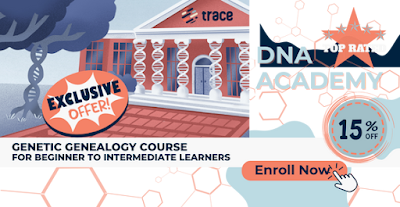I'm coming to the end of my one-month subscription to Ancestry Pro Tools. I took the important step of following blog reader Jon Smith's suggestion. I used the "Ancestry DNA Match Table Maker" spreadsheet to download all my matches. (This powerful tool is the creation of Greg Clarke.) Now I have one spreadsheet with 4 tabs containing every DNA match for myself, Mom, Dad, and my husband.
 |
| When you search for contemporary cousins, your family tree really comes to life. |
I went through my parents' matches sharing 30 cM or more with them and color-coded everyone who's also on my list. Then I used a neat Excel trick to display those people's research notes from my tab on Mom or Dad's tabs. That ensures that I can see who I've identified and what I know about their families. (Leave a comment if you want me to explain this trick.)
Using tips I shared with you last week (see "How to Solve a DNA Match Using Shared Matches"), I've solved a ton of matches. I've discovered cousins I never knew existed! I solved matches who were a complete mystery with the help of Enhanced Shared Matches.
Researching Living People
I'm so used to researching my long-dead Italian relatives. My recent focus on DNA matches has me locating living people for the first time. I didn't realize how much success I could have in researching the living.
Here are 6 steps to follow when searching for living cousins:
- Start with an ancestor you can identify. I know, tons of your matches have no family tree to show. But what if their first cousin does? Look for an ancestor you can pin down using a search.
- Gather every document for that ancestor: immigration, naturalization, censuses, draft registration cards, death records or indexes.
- Build out their family members through the years using the censuses you found. Add to their details with individual searches for each family member. See who they married and which kids they had.
- Look for an obituary with the names of children and their spouses, grandchildren, and hometowns. OMG do I love a good obituary! My newspapers.com subscription is essential here. You can't get the full story from an obituary summary. Which names are the deceased's children and which are spouses? I've also been following my own advice to extract text from an obituary instead of retyping it.
- Search public index records, marriage indexes and announcements, school yearbooks, and more to confirm all you can about family members.
- Turn to social media to see who you can find. If available, look at their friends and see who comments on their photos. Did the subject post a photo of dad, and did someone comment on it using the dad's name? That's exactly what cracked one mystery DNA match for me.
Discovering Where Your Paths Crossed
Using this process, I've ID'd DNA matches who helped me find my ancestors' lost cousins. Who knew one of mom's Saviano cousins wound up in Cleveland, not far from where dad once lived? A DNA match helped me find my connection (7C1R) to a former bishop of Cleveland I'd heard about many years ago. And I found that my brother went to high school in New Jersey with one of our 7th cousins. You never know where your cousins may be.
This is the value of DNA matches for me. My direct ancestor chart is in fantastic shape. But this research tells me what became of my direct ancestors' closest relatives. It's an exciting, coincidence-filled journey.
In a week I'll return to adding source citations for my thousands of Italian nationals, and doing it efficiently. But I'll also take every opportunity to follow the families of those who emigrated to America.
If you're interested in finding living cousins you've never met, the tools you need are out there.







